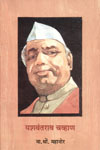The increase of Rs. 13 crores over the interim Budget for the development, of major and minor parts is meant for development. Modernisation and improvement of the existing major ports particularly Vishakhapattanam, Haldia, Madras and Cochin. This is specially necessary in order to enable these ports to handle larger ships and larger volume of exports of iron ore and import of crude oil.
The increase in the provision in the Central Plan for roads, education and social services which is of the order of Rs. 40 crores is basically employment-oriented. How can anybody say this is merely infra-structure? These 40 crores investments are essentially employment-oriented. When we talk of crash employment programme and educated employment programme of the order of Rs. 25 crores and many other investments, these are all employment oriented investments. It is said, it is a small thing, a drop in the ocean. Well, I think, we have to take a major share of whatever ocean we have; we cannot take oceans from nowhere. Ultimately the oceans are in our own pockets and they are small pockets. But what can we do about it?
These increased investments in public sector undertakings are essentially employment oriented. The balance of the additional Rs. 300 crores Will be allocated in the following sectors, namely, Agriculture and Food, Rs. 78 crores, including purchase of buffer stocks; Irrigation and Power Rs. 10 crores, P&T Rs. 11 crores and others Rs. 35 crores. If this is not growth, I do not know what else is growth.
So, the main question is whether I would have been justified in raising resources on an even more ambitious scale than what I have proposed for, or leaving a larger deficit in the Budget. I am sure that Dr. Rao will not advocate either of these two courses. For, if I had kept this whole deficit uncovered, what would have been the inflationary effect of it? Really speaking, every Finance Minister of a nation is on the horns of a dilemma in this regard, namely ‘Shall I leave the deficit uncovered and have flood of inflationary forces or shall I not?’ If he levies taxes, then in a country like ours, where indirect taxes have to be resorted to, some erratic and irrational reactions occur and these certainly let loose certain forces of price instability and inflation. I am quite aware of them. But I shall deal with that matter again when I come to the question of price stability and other matters.
The provision that we have made fully takes into account the requirement of all public sector enterprises which are under way and for all the projects included in the Plan outlay which are likely to be taken up the coming year. I can assure the House that if the enterprises now under construction such as Bokaro, the fertiliser plant and the like require a larger allocation than what we have now provided, we shall come up with the necessary request for supplementary provision and would not in any case allow the implementation of these projects to be slowed down for financial reasons. If there are any other reasons, I cannot help it. But I can assure the House that if their performance is good and they need some more money they will not be slowed down only on account of financial paucity, I think I have taken care of the point that was raised by Dr. V. K. R. V. Rao about the growth rate.
























